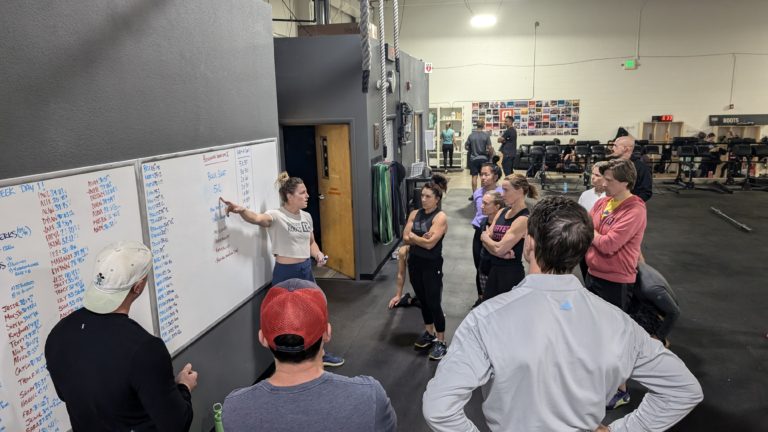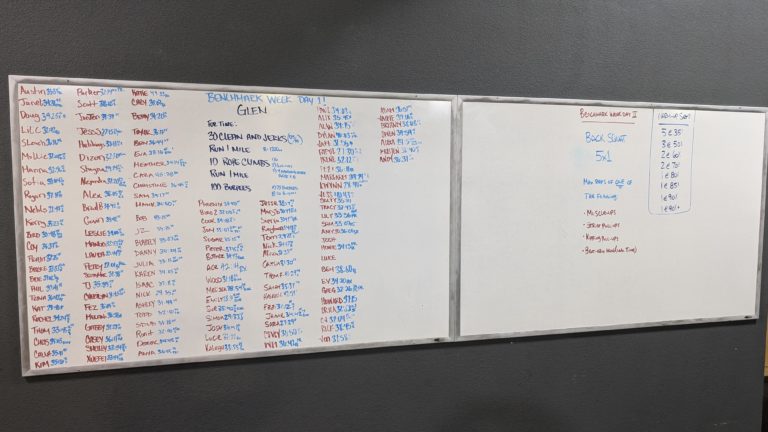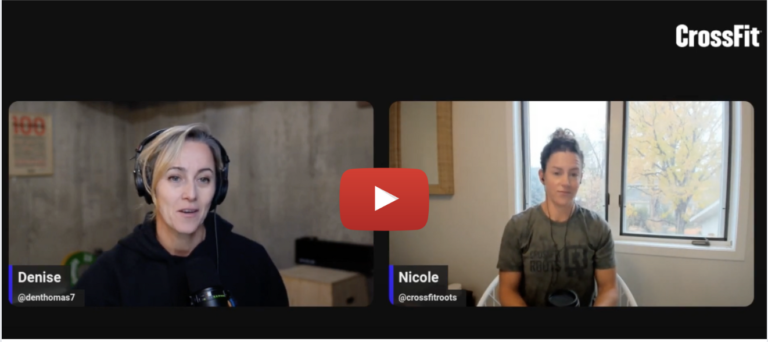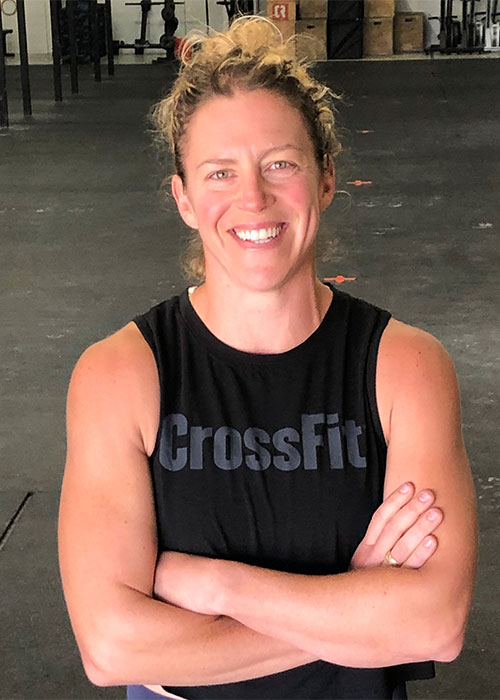At CrossFit Roots, every group class starts and ends at the whiteboard. Every single class. This consistent practice has been a cornerstone of our class structure since we opened 15+ years ago, and it continues to evolve and strengthen our gym and community. Here’s why the whiteboard is such an essential part of our approach.
Why the Whiteboard?
 You might wonder why we dedicate so much time and attention to the whiteboard. Aren’t those 2-3 minutes better spent warming up or training? While it may seem small, those few minutes at the whiteboard before EVERY class create enormous value toward clear communication, class efficiency, athlete progress, and community. This routine allows our coaches to provide clear, concise instructions, establish leadership, and foster class cohesion.
You might wonder why we dedicate so much time and attention to the whiteboard. Aren’t those 2-3 minutes better spent warming up or training? While it may seem small, those few minutes at the whiteboard before EVERY class create enormous value toward clear communication, class efficiency, athlete progress, and community. This routine allows our coaches to provide clear, concise instructions, establish leadership, and foster class cohesion.
In fact, I often think about all the positive ripple effects of an effective whiteboard delivery. It’s not just about reading the Workout of the Day (WOD) verbatim — it’s about setting the tone and tempo for the entire class. When done right, whiteboard time builds trust, strengthens the coach-athlete relationship, and reinforces our gym’s culture.
Establishing Leadership and Expectations
One of the primary reasons we start every class at the whiteboard is to establish the coach as the class leader. We aren’t rigid or militaristic in our coaching style, but we expect athletes to listen to and respect the coach. By gathering everyone at the whiteboard, the coach signals that the workout is about to begin, expectations are set, and goals will be laid out clearly.
This time at the whiteboard sets the foundation for the coach-athlete dynamic for the entire class. It makes athletes feel taken care of, and they know no matter where they are physically and sometimes emotionally, relative to other class athletes, they’ll get the coaching they need during class.
Efficiency and Scaling Options
Efficiency is another huge benefit of the whiteboard routine. We cover the workout details, the stimulus, scaling options, and time domains upfront, which eliminates confusion during the class. For example, we might say, “If you did Diane last time and finished in under 7 minutes, add 5 to 10 lb to the bar today.” This direction helps athletes think critically about their performance and scaling choices, reinforcing that scaling for intensity is far more important than chasing an Rx’d workout that doesn’t match their ability level.
Introducing scaling options early gives athletes the tools to make informed decisions about their workout in partnership with their coach. Because we consistently emphasize this process, athletes know they’ll always have a safe, effective way to scale or modify the workout. This reduces anxiety, builds confidence, and encourages athletes to show up even on days when they aren’t sure how they’ll approach the WOD.
As an important side note, conversations around scaling and modification must continue into the general and specific warm-ups to bring more depth and insight to the scaling options through practice, building loads, and capacity check-ins. By giving athletes real information and data to anchor and assess their abilities, coaches can guide athletes toward the right answer for their long-term development.
As an affiliate, we never get questions like, “What if I can’t do that?” or ” What’s a box push-up?” at the whiteboard because our athletes know we’ve already planned and thought through scaling options and progressions for every workout. They know it will all be covered in the class, and this is just setting the stage. This trust is built over time, thanks to the consistent delivery of information at the whiteboard.
Class Cohesion and Accountability
 Another essential aspect of the whiteboard routine happens at the end of class. After the workout, we gather back at the whiteboard to collect scores, where the coach handwrites every athlete’s name and score. Calling out each athlete’s name and having them report their score, loads, and scaling options encourages interaction and helps athletes bond over how the workout went for each. It also promotes honest score reporting, which is critical for creating a culture of accountability, working hard, and working your weaknesses.
Another essential aspect of the whiteboard routine happens at the end of class. After the workout, we gather back at the whiteboard to collect scores, where the coach handwrites every athlete’s name and score. Calling out each athlete’s name and having them report their score, loads, and scaling options encourages interaction and helps athletes bond over how the workout went for each. It also promotes honest score reporting, which is critical for creating a culture of accountability, working hard, and working your weaknesses.
In addition to fostering a team training environment and athlete togetherness, collecting scores at the whiteboard reinforces our expectation that athletes remember the details of their workout. Knowing they’ll be asked to report their score encourages athletes to stay engaged with the WOD, track their performance, and take ownership of their progress. It is safe to say that if you never ask athletes to recall what weight they had on their bar, they will not develop a connection and understanding to the load, the movement, and the various ways the loads can feel at different rep schemes.
This practice also makes the coach’s job easier. By gathering everyone at the whiteboard, we can assess the group as a whole, identify any outliers, and adjust the plan accordingly. Additionally, when the coach writes down the scores for each athlete, they develop a deep understanding of each athlete’s abilities. It’s incredible how the simple but deliberate act of writing down information about each athlete EVERY time they take class helps us understand their abilities and needs more completely. Whether it’s scaling options, pacing, or specific movement coaching, the information gathered at the whiteboard helps us deliver a better experience for everyone in the class.
Communicating the Details
So, what exactly do we cover at the whiteboard? At the start of class, the coach calls everyone over, signaling it’s time to transition from warm-up or chit-chat mode into focused workout mode. Athletes know that once they hear, “8:30, come to the whiteboard!” it’s time to pay attention. More so, they know it’s game time, and time to shift the mental gear into a different mode and focus for class.
We start with a brief hello and then read the workout aloud. While reading something already written on the board might seem unnecessary, you’d be surprised how many athletes are auditory learners or have only skimmed the workout posted online the night before. Reading the workout out loud ensures everyone is on the same page. This is often when we get the “Aha!” moments, like “Oh, the handstand push-ups are strict?!” Those small details make a big difference in how athletes approach the WOD.
Time Domains and No Time Caps
We also cover the workout’s intended time domain, which is crucial for guiding athletes’ decisions about loading and scaling. For example, if the workout is meant to be done in 6 to 9 minutes, we’ll tell athletes how to scale appropriately to hit that target. We don’t use time caps at CrossFit Roots. They are actually one of my biggest coaching pet peeves. Time caps have two downsides. First, they’re a coaching cop-out. When used, time caps take responsibility and accountability away from the coach who no longer has to be able to predict a time domain, learn to scale workouts properly, or do better class planning. It also allows athletes to avoid the intended stimulus and intensity and do the workout slower, knowing they’ll just get time-capped if they can’t do it. Instead of time caps, we emphasize appropriate scaling (loads, reps, rounds, distances, etc.) and pacing so athletes can maximize every WOD.
Injuries
At Roots, we never kick off class by asking about injuries. It sends the wrong message — almost like a warning sign injury is possible or even likely with workouts, which isn’t true. It’s not something I want to put in my athlete’s head on a daily basis. Instead, we take a proactive approach. Athletes are well aware of our policy: if something feels off, they know to let their coach know. We’ve made this crystal clear over the years through blog posts, our website, and direct communication. Because we scale every workout for each athlete’s needs, modifications are common and understood to be just as challenging as the original movements — never “easier.” Our approach empowers athletes to speak up without fear and to recognize that intelligent scaling is part of long-term progress, not a setback.
If you’re looking for ways to set this in motion, try saying, “OK, everyone, head out on a 400-meter run. If you have something going on, come talk to me.” This keeps it open-ended and lets athletes know they can check in with you without the group announcement about injuries.
Questions and Clarifications
Before we leave the whiteboard, we always take a moment to ask if anyone has a question. We get two types of questions: legitimate workout clarifications, and personal or irrelevant questions. Our coaches are trained to handle these effectively, ensuring the whiteboard time is not derailed by questions unique to one athlete. If someone asks, “What if I can’t do box handstand push-ups?” the coach will reply, “No problem, I’ll check in with you during the handstand push-up warm-up,” keeping the focus on the group and avoiding one-on-one discussions in front of the whole class.
Announcements, New Athletes, and Persona
We also use whiteboard time for announcements — whether about an upcoming event, challenge, or sign-up. This is when we introduce new athletes or drop-ins, making them feel welcome and ensuring the class knows who is new versus who is coming from a different class hour.
Finally, the coach’s persona during whiteboard time is critical. Whether it’s 5:30 a.m. or 6 p.m., our athletes expect energy, enthusiasm, and professionalism from their coach. We don’t let our personal struggles interfere with the athlete experience — no matter what’s going on, the coach’s job is to deliver an engaging, fun, and informative class.
A Call to Action
Our whiteboard routine is so much more than a few minutes of instruction. It sets the tone for the entire class, builds trust, and creates a more cohesive and engaged community. Want to experience the difference? Next time you’re in class, take a moment to reflect on how the whiteboard time shapes your workout and your relationship with your coach and fellow athletes.
Watch this video of Denise Thomas and me breaking down the whiteboard even more and how to use it to build trust, track results, and create community here.

 Nicole Christensen opened
Nicole Christensen opened